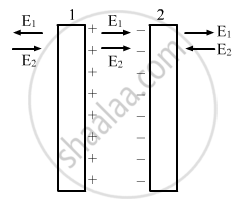Advertisements
Advertisements
प्रश्न
Two large conducting plates are placed parallel to each other and they carry equal and opposite charges with surface density σ as shown in the figure. Find the electric field (a) at the left of the plates (b) in between the plates and (c) at the right of the plates.

उत्तर
Given:-
Surface charge density on the plates = σ
The electric field due to plate 1, E1 = `sigma/(2∈_0)`
The electric field due to plate 2, E2 = `sigma/(2∈_0)`
(a) The strength of the electric field due to both the plates will be same but their directions will be opposite to each other on any point at the left of the two plates.
Thus, the net electric field at a point on the left of plate1 = `sigma /(2∈_0) - sigma/(2∈_0) = 0`
(b) Here the direction of the fields will be same. So, they will add up to give the resultant field in this region.
Total electric field:-
`sigma/(2∈_0) + sigma /(2∈_0) = sigma/∈_0 `
(c) The strength of the electric field due to both the plates will be same but their directions will be opposite to each other at any point on the right of the two plates.
Thus, the net electric field at a point on the left of plate 2 = `sigma /(2∈_0) - sigma/(2∈_0) = 0`

APPEARS IN
संबंधित प्रश्न
A conducting sphere of radius 10 cm has an unknown charge. If the electric field 20 cm from the centre of the sphere is 1.5 × 103 N/C and points radially inward, what is the net charge on the sphere?
How does Ampere-Maxwell law explain the flow of current through a capacitor when it is being charged by a battery?
Write the expression for the displacement current in terms of the rate of change of electric flux.
A point charge is brought inside an electric field. The electric field at a nearby point
(a) will increase if the charge is positive
(b) will decrease if the charge is negative
(c) may increase if the charge is positive
(d) may decrease if the charge is negative
Two particles A and B, each with a charge Q, are placed a distance d apart. Where should a particle of charge q be placed on the perpendicular bisector of AB, so that it experiences maximum force? What is the magnitude of this maximum force?
The electric force experienced by a charge of 1.0 × 10−6 C is 1.5 × 10−3 N. Find the magnitude of the electric field at the position of the charge.
A positive charge q is placed in front of a conducting solid cube at a distance d from its centre. Find the electric field at the centre of the cube to the charges appearing on its surface.
Choose the correct option.
Two point charges of +5 μC are so placed that they experience a force of 8.0 × 10-3N. They are then moved apart so that the force is now 2.0 × 10-3N. The distance between them is now
One metallic sphere A is given a positive charge whereas another identical metallic sphere B of exactly the same mass as A is given an equal amount of negative charge. Then
Ionization of a neutral atom is the ______.
Electric field lines provide information about ______.
Equal charge are given to two-sphere of different radii. The potential will be
Which one of the following is the unit of electric charge?
A positive charge particle of 100 mg is thrown in opposite direction to a uniform electric field of strength 1 × 105 NC–1. If the charge on the particle is 40 μC and the initial velocity is 200 ms-1, how much distance it will travel before coming to the rest momentarily ______.
A certain charge Q is divided into two parts q and (Q - q). How should the charges Q and q be divided so that q and (Q - q) placed at a certain distance apart experience maximum electrostatic repulsion?
A particle of mass m and charge q is placed at rest in a uniform electric field E and then released. The kinetic energy gained by the particle after moving a distance of y will be ______.
The electrostatic potential inside a charged spherical ball is given by `Phi = ar^2 + b`, where r is the distance from the centre a, and b are constants. Then the charge density inside the ball is ______.
A charge of magnitude 3e and mass 2m is moving in an electric field E. The acceleration imparted to the charge is ______.
